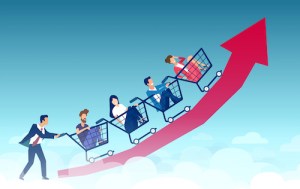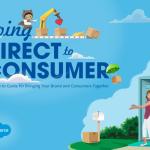Consumer goods sales strategies are top of mind for many companies as the world gradually recovers from the COVID-19 pandemic. The last 18 months brought about some very unique challenges for business. This is why The State of Salesforce 2020-21: Special Edition, compiled by IBM for 2020-2021, is slightly different for its 9th edition.
For the first time, the report includes five industry-specific ‘deep dives’. These deep dives share insights from different industries, covering how they responded to and dealt with the challenges caused by the COVID-19 pandemic. One of the industries focused on in the report is Consumer Packaged Goods (CPG)/retail. So we spoke to Klaus-Peter Gölz, Executive Partner at IBM, and Jez Bassinder, UKI Salesforce Consulting Services Leader at IBM.
We wanted to learn the most successful consumer goods sales strategies that have come out of the pandemic. As Jez explained, “This year’s report is more focused on the content of the world we’re living in at the moment and how organisations have had to respond to this dramatically changed world.”
2020-2021 Consumer Good trends and challenges
Consumer goods companies faced multiple disruptions due to the pandemic. New competition appeared customer expectations became more challenging, and profit margins narrowed. So how did consumer goods companies adapt to this new environment, survive, and thrive?
“They’ve realised they can use Salesforce technology to massively increase these types of initiatives and this is the biggest difference we’re seeing to previous years,” said Klaus-Peter.
Being a high-touch industry, consumer goods faced some very specific challenges. With social distancing measures and lockdowns happening globally, the impact was substantial. And it’s not only the way people shopped that was dramatically altered, it was the way people worked as well.
“If you have a workforce but only a percentage of them could be in-store, the workforce has to change and the job has to be split in different ways,” Jez explains. “What you then start to see is a change in how consumers engage with retailers, which meant that the consumer product companies had to find ways to help their people engage with the process differently.”
Finding the right consumer goods sales strategy and channel
There was a marked increase in products being sold DTC (direct-to-consumer) through marketplaces. This meant having to get products into a marketplace the same way as they were getting into stores.
The pressure on omnichannel also increased as consumers gravitated towards initiatives such as click and collect. However, retailers had issues with mismatching stock so some people buying online couldn’t actually pick them up where and when they were expecting to.
“The businesses that were reluctant to spend too much on e-commerce because physical stores brought more profit than online business have had to learn the hard way that they need to prepare for potential crises like the pandemic,” said Klaus-Peter.
Consumer goods sales strategies, trends, and handling challenges
One of the major lessons learned from the COVID-19 pandemic was around budgeting for e-commerce spending. For instance, offering a strong online presence is a must-have, no longer just a nice-to-have.
The State of Salesforce report looked at several trends that have been key in the evolving consumer landscape:
Trust is the new currency of customer engagement
Trust has always been the currency of customer engagement. The brands that successfully made it through the pandemic were the ones that took steps to build on that trust, rather than losing it.
An example of this is UK retail giant Ocado, which saved delivery slots for long-standing customers when online grocery shopping was at its peak during the pandemic.
Human-centred AI creates new business value
With higher customer expectations, the use of chatbots increased. The problem is that chatbots make it easier to deal with a greater volume of customers, but aren’t the best route to customer satisfaction.
“You need to be able to address the most important cases first, instead of all of them at once,” said Jez. “And that’s where human-centred AI helps. The first line is a chatbot, but then it’s using AI to direct customers to the right team, teams that were likely reduced because of the pandemic.”
According to the State of Salesforce report:
- 45% of consumer goods company respondents currently use enterprise AI.
- 84% of consumer goods company respondents expect to deploy enterprise AI solutions within the next year.
Employee safety and well-being build resilient business
The majority of the consumer goods industry had to deal with pandemic-related issues concerning their frontline workers. Strategies were needed to test employees and prioritise vaccinations.
The Vaccine Cloud received positive feedback from customers in the industry and its impact on their ability to carry on throughout the pandemic.
A good customer goods sales strategy starts with the right solutions
More and more consumer goods companies are increasing their use of Salesforce solutions to become smarter, more resilient, and more prepared for whatever the current climate throws at them.
You can read more about the top consumer goods sales strategies and trends of 2020-2021 in The State of Salesforce: Industry Perspectives.













